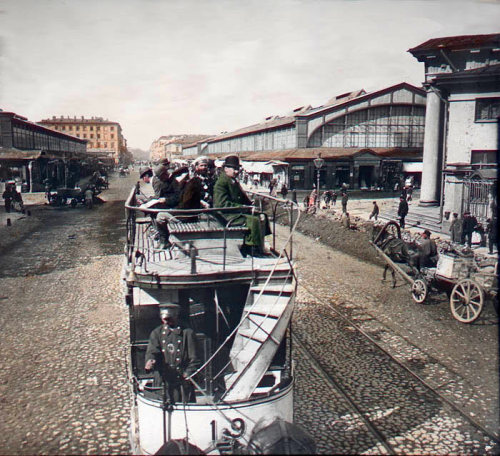#petrograd

The deck of the Petropavlovskafter the defeat of the rebellion.
March 17 1921, Kronstadt [Kotlin]–The failure of the initial attack on Kronstadt was an embarrassment for the Communists, who on the same day convened their Tenth Party Congress in Moscow. On March 10, after Trotsky reported on the situation, 320 delegates volunteered to join the fight. With the spring fast approaching and the ice in the Gulf of Finland threatening to melt, Tukachevsky had to act quickly.
While he prepared another offensive, events moved even quicker at the Congress in Moscow. Lenin had found himself facing direct threats from Kronstadt, strikes in the major cities, and widespread peasant rebellions, along with internal opposition in the form of the Alexander Shliapnikov and Alexandra Kollontai’s Workers’ Opposition. The strikes had largely petered out by mid-March, with promises that trade would resume with the countryside and the food situation would improve. Kronstadt would be crushed by force. The Workers’ Opposition would be effectively dissolved by a ban on internal Communist Party factions, passed without fanfare on April 16 but which would confirm a dictatorship until Gorbachev.
The farmers, Lenin chose to mollify. Food had heretofore been requisitioned from communities in large quantities by the government. This system was to be turned into a tax, 45% lower than the previous rate, and levied on an individual basis. Any remaining food could be sold on the open market, and additional incentives were provided to boost production. What would become the New Economic Policy pleased the farmers who directly benefited, and the city-dwellers whose food worries would be alleviated; it had only taken a betrayal of Communist ideals. Lenin justified this before the Congress on March 15 by saying that an alliance with the peasants was needed if Communism was to survive in a relatively non-industrialized country like Russia without outside help–but after years of war, there was little opposition to a policy that might bring an end to the conflicts.
The announcement of the land tax also boosted the morale of Tukachevsky’s forces, which had also been reinforced with loyal Communists from around the country. He began another bombardment of Kronstadt on the afternoon of the 16th, and his infantry attacked across the ice in the wee hours of the 17th. Casualties were high; over 10,000 (including 15 of the party delegates who had volunteered from Moscow) were felled by the defenders or were lost through holes in the ice. But shortly before midnight, the Communists had captured the Petropavlovskand most of the other rebellious ships. About 8000 of the rebels escaped across the ice to Finland; most of those captured by the Communists were shot or died in a concentration camp on the White Sea.
Sources include: Orlando Figes, A People’s Tragedy; W. Bruce Lincoln, Red Victory.
March 1 1921, Kronstadt–Aside from the distant reaches of the Far East, the Whites had been defeated, but severe threats to Bolshevik power remained and even intensified. Revolts spread across the countryside after a poor harvest added to years of hardship from Bolshevik grain requisition. In the cities, hunger became a major concern; by late January, the food ration provided to workers in Moscow and Petrograd was down to 1000 calories a day. Large strikes broke out in Moscow on February 21 and Petrograd the next day, calling for the reconvening of the Constituent Assembly, freedom of movement (most critically, the freedom to go into the countryside and trade for food there, a pattern that had become very familiar in Russia and Germany during the war) and other rights that had been denied by the Bolshevik government. The parallels with the final days of the Czar were undeniable.
The unrest soon spread to the Kronstadt Naval Base, whose sailors had been in the vanguard of leftist opposition to the Provisional Government in 1917. On February 28, the crew of Petropavlovsk,historically staunch Bolsheviks, issued a proclamation calling for new elections for the soviets, full political freedoms for workers, peasants, left socialists and anarchists, and allowing peasants to manage their own land as they see fit as long as they do not hire labor. The proclamation was undeniably left-wing (unlike the strikers in the city, they notably did not call for the Constituent Assembly), but was a clear call for democratization of the Soviets (albeit with participation still extending no further right than the left SRs) and an end to the Bolshevik dictatorship.
On March 1, a crowd of 15,000 met in Anchor Square and agreed for new elections to the local Soviet. The Bolsheviks sent Kalinin to try to defuse the situation, but he only attracted jeers. The next day, rightfully worried that the Bolsheviks would quickly try to take action against them, a Revolutionary Committee of five was elected to organize elections and a defense of the island.
Sources include: Orlando Figes, A People’s Tragedy; W. Bruce Lincoln, Red Victory.
Boris Souvarine papers. At the Revolt Square. Petrograd, ca. 1920 The sign reads: «Salute to the true leaders of the social revolution»
Post link




